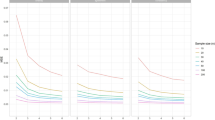Abstract
Assuming Cox’s regression model, we consider penalized full likelihood approach to conduct variable selection under nested case–control (NCC) sampling. Penalized non-parametric maximum likelihood estimates (PNPMLEs) are characterized by self-consistency equations derived from score functions. A cross-validation method based on profile likelihood is used to choose the tuning parameter within a family of penalty functions. Simulation studies indicate that the numerical performance of (P)NPMLE is better than weighted partial likelihood in estimating the log-relative risk and in identifying the covariates and the model, under NCC sampling. LASSO performs best when cohort size is small; SCAD performs best when cohort size is large and may eventually perform as well as the oracle estimator. Using the SCAD penalty, we establish the consistency, asymptotic normality, and oracle properties of the PNPMLE, as well as the sparsity property of the penalty. We also propose a consistent estimate of the asymptotic variance using observed profile likelihood. Our method is illustrated to analyze the diagnosis of liver cancer among those in a type 2 diabetic mellitus dataset who were treated with thiazolidinediones in Taiwan.

Similar content being viewed by others
References
Borgan Ø, Zhang Y (2015) Using cumulative sums of martingale residuals for model checking in nested case–control studies. Biometrics 71(3):696–703
Chang IS, Hsiung CA, Wang MC, Wen CC (2005) An asymptotic theory for the nonparametric maximum likelihood estimation in the Cox-gene model. Bernoulli 11(5):863–892
Chang CH, Lin JW, Wu LC, Lai MS, Chuang LM, Chan KA (2012) Association of thiazolidinediones with liver cancer and colorectal cancer in type 2 diabetes mellitus. Hepatology 55(5):1462–1472
Chen KN (2001) Generalized case-cohort sampling. J R Stat Soc B 63(4):791–809
Chen HY (2002) Double-semiparametric method for missing covariates in Cox regression models. J Am Stat Assoc 97(458):565–576
Fan J, Li R (2001) Variable selection via nonconcave penalized likelihood and its oracle properties. J Am Stat Assoc 96(456):1348–1360
Fan J, Li R (2002) Variable selection for Cox’s proportional hazards model and frailty model. Ann Stat 30(1):74–99
Fan J, Lv J (2008) Sure independence screening for ultrahigh dimensional feature space. J R Stat Soc B 70(5):849–911
Gau CS, Chang IS, Lin Wu FL, Yu HT, Huang YW, Chi CL, Chien SY, Lin KM, Liu MY, Wang HP (2007) Usage of the claim database of national health insurance programme for analysis of cisapride–erythromycin co-medication in Taiwan. Pharmacoepidemiol Drug Saf 16(1):86–95
Giovannucci E, Harlan DM, Archer MC, Bergenstal RM, Gapstur SM, Habel LA, Pollak M, Regensteiner JG, Yee D (2010) Diabetes and cancer: a consensus report. CA Cancer J Clin 60(4):207–221
Hunter DR, Li R (2005) Variable selection using MM algorithms. Ann Stat 33(4):1–8
Kim RS (2013) Lesser known facts about nested case–control designs. J Transl Med Epidemiol 1(1):1007
Liu ML, Lu WB, Shore RE, Zeleniuch-Jacquotte A (2010) Cox regression model with time-varying coefficients in nested case-control studies. Biostatistics 11(4):693–706
Ni A, Cai JW, Zeng DL (2016) Variable selection for case-cohort studies with failure time outcome. Biometrika 103(3):547–562
Nicolucci A (2010) Epidemiological aspects of neoplasms in diabetes. Acta Diabetol 47(2):87–95
Prentice RL (1986) A case-cohort design for epidemiologic cohort studies and disease prevention trials. Biometrika 73(1):1–11
Saarela O, Kulathinal S, Arjas E, Läärä E (2008) Nested case-control data utilized for multiple outcomes: a likelihood approach and alternatives. Stat Med 27(28):5991–6008
Samuelsen SO (1997) A pseudolikelihood approach to analysis of nested case–control studies. Biometrika 84(2):379–394
Scheike TH, Juul A (2004) Maximum likelihood estimation for Cox’s regression model under nested case–control sampling. Biostatistics 5(2):193–206
Scheike TH, Martinussen T (2004) Maximum likelihood estimation for Cox’s regression model under case-cohorts sampling. Scand J Stat 31(2):283–293
Støer NC, Samuelsen SO (2012) Comparison of estimators in nested case–control studies with multiple outcomes. Lifetime Data Anal 18(3):261–283
Thomas DC (1977) Addendum to “methods of cohort analysis: appraisal by application to asbestos mining,” by Liddell FDK, McDonald JC, Thomas DC. J R Stat Soc A 140(4):483–485
Tibshirani R (1996) Regression shrinkage and selection via the lasso. J R Stat Soc B 58(1):267–288
Tibshirani R (1997) The lasso method for variable selection in the Cox model. Stat Med 16(4):385–395
Verweij PJM, Van Houwelingen HC (1993) Cross-validation in survival analysis. Stat Med 12(24):2305–2314
Vigneri P, Frasca L, Sciacca L, Pandini G, Vigneri R (2009) Diabetes and cancer. Endocr Relat Cancer 16:1103–1123
Zhao SD, Li Y (2012) Principled sure independence screening for Cox models with ultra-high-dimensional covariates. J Multivar Anal 105(1):397–411
Zhao SD, Li Y (2014) Score test variable screening. Biometrics 70(4):862–871
Acknowledgements
Funding was provided by Ministry of Science and Technology, Taiwan (Grant No. MOST-105-2319-B400-002). We are very grateful to the AE and referees, whose valuable comments and suggestions led to significant improvement of this paper.
Author information
Authors and Affiliations
Corresponding author
Additional information
Publisher's Note
Springer Nature remains neutral with regard to jurisdictional claims in published maps and institutional affiliations.
Electronic supplementary material
Below is the link to the electronic supplementary material.
Rights and permissions
About this article
Cite this article
Wang, JH., Pan, CH., Chang, IS. et al. Penalized full likelihood approach to variable selection for Cox’s regression model under nested case–control sampling. Lifetime Data Anal 26, 292–314 (2020). https://doi.org/10.1007/s10985-019-09475-z
Received:
Accepted:
Published:
Issue Date:
DOI: https://doi.org/10.1007/s10985-019-09475-z




